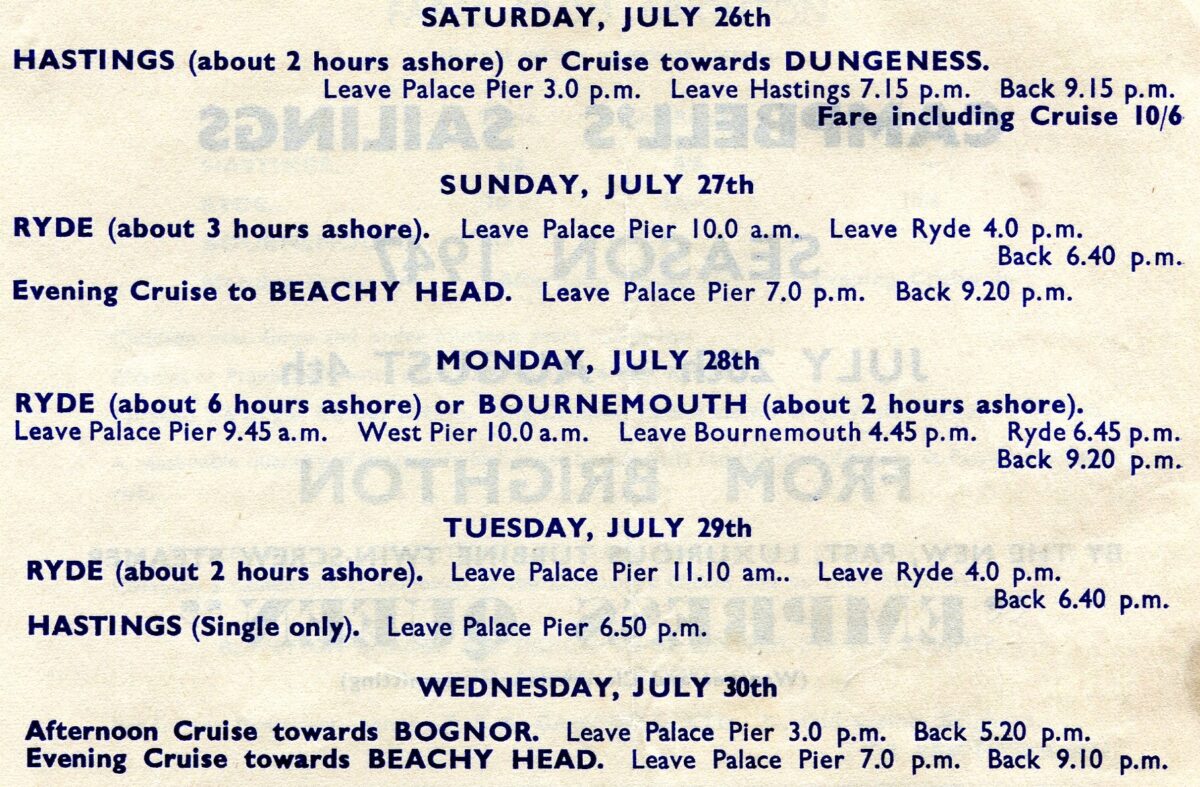
With all the South Coast piers breached during the Second World War to prevent enemy ships from landing alongside and disgorging troops, agents or whatever from their decks, it was not until 1947 that Hastings and both Brighton’s West and Palace Piers were in suitably rebuilt form to reopen and accept calls from P & A Campbell’s steamers once again. Eastbourne had to wait until 1948 for its pier to open once again.
Glen Gower, under the command of Captain Phillips, steamed round from the Bristol Channel to be ready to start the season with local cruises from Brighton and Hastings on Wednesday 24th May 1947.

On Monday 30th June she left the Palace Pier at 9.40am and the West Pier at 10am for Ryde and continued on to Bournemouth for the first time this season where she was due in at 2.40pm, ten minutes after the Cosens’s and Red Funnel steamers had left for Swanage and the Isle of Wight. Two hours ashore were advertised with departure at 4.40pm, a call at Ryde at 6.50pm and with return to Brighton at 9.50pm.

Glen Gower’s visit to Bournemouth was reported the following day in the Bournemouth Daily Echo with mention made that she was “bigger than any of the paddle steamers that normally use the pier”, that “She will carry well over 1,000 passengers” and that “Her round trip is over 150 miles”. Her skipper “told the Echo that he would be sailing from Brighton to Bournemouth twice again this season”.

In that he was wrong. Glen Gower left Newhaven on Saturday 12th July to return to operate on the Bristol Channel, her place on the Sussex Coast being taken by the giant turbine steamer Empress Queen which made her first trips the same day offering local cruises from Brighton and Hastings.

It was therefore Empress Queen which, on Monday 28th July, made the second Brighton to Bournemouth round trip of the season to broadly similar timings to that of Glen Gower the previous month but getting back to Brighton half an hour earlier at 9.20pm. With a speed of 20 knots through the water she was a fast ship.

Her arrival in Bournemouth at 2.45pm caused quite a stir. She was just so big. The Echo reported that “She was watched by large crowds from beach and pier”, that she was “towering over the pier” and that “It is probable Empress Queen will visit Bournemouth again this year.”
In that they were wrong too. No more trips from Brighton to Bournemouth were scheduled for the season even though Empress Queen went on up to Sunday 14th September when she was rostered for a day trip from Brighton to Ryde.
So why was that? Why didn’t she come to Bournemouth again? E C B Thornton in his excellent book “South Coast Pleasure Steamers” makes mention of her draught at some of the piers being an issue and he includes Bournemouth in this. But might there have been another factor as well?
I have a copy here with me of the “County Borough of Bournemouth Byelaws to Regulate the Use of the Bournemouth and Boscombe Piers”. On page 6, Byelaw 11 states “No vessel other than a passenger vessel of a gross tonnage not exceeding 800 tons or with a draught of not more than 7 feet, shall traffic at the Pier or under any pretence whatever touch at the Pier except with the permission of the Pier Master.

I think that we can take it that Empress Queen had the permission of the Pier Master as we know from the press report that he welcomed her master Captain Jack George. Maybe at that stage, and before the ship arrived, he had not realised just how big she was and thought of her as just another Campbell steamer. Maybe he did not know that she had a gross registered tonnage of 1,781 tons, more than double the limiting parameter in the byelaws. And a draught of 8ft, 1ft more than the Byelaws allowed.
So after she had arrived did someone quietly point all this out to him? Or maybe he just realised himself when he saw her and took the trouble to look up her statistics.
Whatever the case and whatever quiet words may or may not have been said, Empress Queen was not advertised to sail to Bournemouth from Brighton again in 1947 nor in any of her remaining seasons on the Sussex Coast in 1948, 1949 and 1950.
Kingswear Castle returned to service in 2023 after the first part of a major rebuild which is designed to set her up for the next 25 years running on the River Dart. The Paddle Steamer Kingswear Castle Trust is now fund raising for the second phase of the rebuild. You can read more about the rebuilds and how you can help if you can here.
John Megoran
This article was first published on 12th July 2021.


